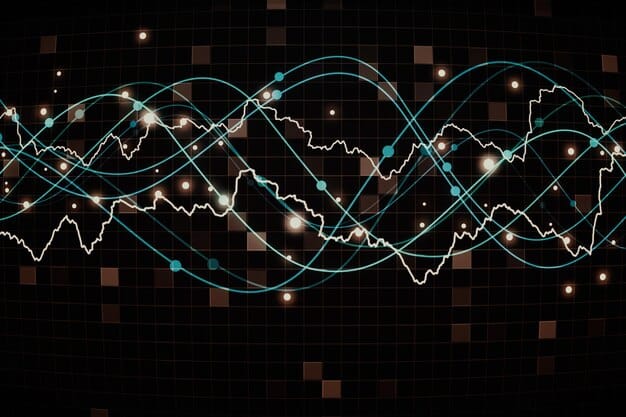Use Technical Analysis for Smart Cryptocurrency Investments in the US

Technical analysis in cryptocurrency investing involves using historical price charts and indicators to predict future price movements, helping investors in the US make more informed decisions about buying and selling digital assets.
Embarking on the journey of cryptocurrency investing can be both exciting and daunting. One powerful tool that can significantly enhance your decision-making process is technical analysis. This guide is designed to show you how to use technical analysis to make smarter cryptocurrency investments in the US.
Understanding Technical Analysis in Cryptocurrency
Technical analysis is a method used to forecast the price and trends in the market by studying past market data, primarily price and volume. Unlike fundamental analysis, which examines a company’s intrinsic value, technical analysis focuses on the patterns and signals generated by trading activity.
In the context of cryptocurrency, where fundamental data can be scarce or unreliable, technical analysis becomes particularly valuable. By mastering the tools and techniques of technical analysis, investors in the US can gain a competitive edge in the volatile crypto market.
Key Principles of Technical Analysis
Before diving into specific indicators and strategies, it’s crucial to understand the underlying principles of technical analysis:
- History Repeats Itself: Technical analysts believe that past price patterns tend to repeat themselves. By identifying these patterns, investors can anticipate future price movements.
- Price Discounts Everything: This principle suggests that all known information is already reflected in the price of an asset. Therefore, studying price charts can provide a comprehensive view of market sentiment.
- Trends Exist: Prices tend to move in trends, whether upward (uptrend), downward (downtrend), or sideways (sideways trend). Identifying these trends is essential for making informed trading decisions.

Technical analysis provides a structured approach to understanding market behavior, allowing US investors to navigate the complexities of the cryptocurrency market with greater confidence. Whether you’re a seasoned trader or just starting out, incorporating technical analysis into your investment strategy can significantly improve your results.
Essential Technical Indicators for Crypto Trading
Technical indicators are mathematical calculations based on historical price and volume data, designed to forecast future price movements. These indicators can be broadly classified into trend-following, momentum, volatility, and volume indicators.
Here are some of the most essential technical indicators for cryptocurrency trading in the US:
Moving Averages (MA)
Moving averages smooth out price data by calculating the average price over a specified period. They are useful for identifying trends and potential support and resistance levels.
Relative Strength Index (RSI)
The RSI is a momentum oscillator that measures the magnitude of recent price changes to evaluate overbought or oversold conditions in the price of an asset. An RSI above 70 typically indicates an overbought condition, while an RSI below 30 suggests an oversold condition.
- MACD (Moving Average Convergence Divergence): MACD is a trend-following momentum indicator that shows the relationship between two moving averages of a price. It is composed of the MACD line, the signal line, and the histogram.
- Fibonacci Retracement Levels: Fibonacci retracement levels are horizontal lines that indicate potential support and resistance levels based on Fibonacci ratios. These levels are often used to identify potential entry and exit points.
- Bollinger Bands: Bollinger Bands consist of a moving average and two bands plotted at a standard deviation above and below the moving average. They are used to measure volatility and identify potential overbought or oversold conditions.
By understanding and applying these essential technical indicators, cryptocurrency investors in the US can gain valuable insights into market dynamics and improve their trading strategies. Each indicator provides a unique perspective, and combining them can lead to more robust trading decisions.

Reading and Interpreting Crypto Charts
Crypto charts are visual representations of price data over time, providing valuable insights into market trends and patterns. Understanding how to read and interpret these charts is crucial for effective technical analysis.
There are several types of charts commonly used in cryptocurrency trading, including:
Candlestick Charts
Candlestick charts are one of the most popular types of charts used in technical analysis. Each candlestick represents the price movement over a specific period, showing the open, high, low, and close prices.
Line Charts
Line charts connect the closing prices over a period, providing a simple and clear view of the overall trend. They are easy to read but lack the detailed information provided by candlestick charts.
- Bar Charts: Bar charts show the open, high, low, and close prices for a specific period, similar to candlestick charts. However, they are less visually appealing and can be more difficult to interpret.
- Identifying Patterns: Chart patterns are recognizable formations on price charts that suggest future price movements. Common patterns include head and shoulders, double tops and bottoms, triangles, and flags.
- Support and Resistance Levels: Support levels are price levels where the price tends to find support and bounce upward, while resistance levels are price levels where the price tends to face resistance and reverse downward.
Mastering the art of reading and interpreting crypto charts is a fundamental skill for any successful cryptocurrency investor in the US. By recognizing patterns, identifying support and resistance levels, and understanding the nuances of different chart types, you can gain a significant advantage in the market.
Developing a Technical Analysis Trading Strategy
Developing a well-defined trading strategy is essential for successful cryptocurrency investing. A technical analysis-based strategy involves using various indicators, chart patterns, and other technical tools to identify potential trading opportunities.
Here’s how to develop a technical analysis trading strategy for the US crypto market:
Define Your Trading Goals
Start by defining your trading goals, including the amount of capital you’re willing to risk, the returns you hope to achieve, and the time horizon you’re comfortable with.
Select Your Indicators
Choose a set of technical indicators that align with your trading style and goals. Consider using a combination of trend-following, momentum, volatility, and volume indicators.
Effective risk management is crucial for protecting your capital and preserving your trading account. Here are some essential risk management techniques:
- Stop-Loss Orders: Always use stop-loss orders to limit your potential losses on a trade. A stop-loss order automatically closes your position when the price reaches a predetermined level.
- Position Sizing: Determine the appropriate position size for each trade based on your risk tolerance and account size. Avoid risking more than a small percentage of your capital on any single trade.
- Diversification: Diversify your cryptocurrency portfolio to reduce the impact of any single asset’s performance on your overall returns.
By developing a comprehensive trading strategy that incorporates technical analysis, risk management, and disciplined execution, cryptocurrency investors in the US can significantly improve their chances of success in the market. A well-defined strategy provides a roadmap for navigating the complexities of the crypto market and making informed trading decisions.
Risk Management and Technical Analysis
Risk management is an essential component of cryptocurrency investing, especially when using technical analysis. While technical analysis can provide valuable insights into potential trading opportunities, it’s important to manage risk effectively to protect your capital.
Here are some key aspects of risk management in technical analysis:
Setting Stop-Loss Orders
A stop-loss order is an order to sell an asset when it reaches a specific price. This helps to limit potential losses if the price moves against your position. When using technical analysis, stop-loss orders can be placed based on support and resistance levels, chart patterns, or indicator signals.
Position Sizing
Position sizing involves determining the appropriate amount of capital to allocate to each trade. This should be based on your risk tolerance and the potential reward of the trade. A common rule of thumb is to risk no more than 1-2% of your total capital on any single trade.
- Diversification: Diversifying your cryptocurrency portfolio can help to reduce risk by spreading your capital across multiple assets. This can help to mitigate the impact of any single asset’s performance on your overall returns.
- Using Leverage Wisely: Leverage can amplify both gains and losses. If you choose to use leverage, do so cautiously and be aware of the potential risks.
- Staying Informed: Keep up-to-date with the latest news and developments in the cryptocurrency market. This can help you to make more informed trading decisions and adjust your strategy as needed.
By implementing effective risk management techniques in conjunction with technical analysis, cryptocurrency investors in the US can protect their capital and improve their chances of long-term success. Risk management is not just about avoiding losses, but also about preserving capital and positioning yourself for future opportunities.
Advanced Technical Analysis Techniques
For experienced traders looking to take their technical analysis skills to the next level, there are several advanced techniques that can provide deeper insights into market dynamics.
Here are some advanced technical analysis techniques for cryptocurrency trading in the US:
Elliott Wave Theory
The Elliott Wave Theory is based on the idea that market prices move in specific patterns called waves. These waves consist of five impulse waves that move in the direction of the trend and three corrective waves that move against the trend.
Harmonic Patterns
Harmonic patterns are geometric price patterns that use Fibonacci ratios to identify potential reversal points. These patterns include Gartley, Butterfly, Bat, and Crab patterns.
- Ichimoku Cloud: The Ichimoku Cloud is a comprehensive indicator that provides information about support and resistance levels, trend direction, and momentum. It consists of five lines that form a “cloud” on the chart.
- Volume Analysis: Volume analysis involves studying the relationship between price and volume to confirm trends and identify potential reversals. High volume during a price move can indicate strong conviction, while low volume may suggest weakness.
- Intermarket Analysis: Intermarket analysis involves studying the relationships between different markets to gain insights into potential trends. This can include analyzing the correlation between cryptocurrencies and other asset classes, such as stocks, bonds, and commodities.
By mastering these advanced technical analysis techniques, cryptocurrency investors in the US can gain a more comprehensive understanding of market behavior and improve their trading strategies. However, it’s important to remember that these techniques are more complex and require practice and experience to use effectively. Always combine advanced techniques with sound risk management principles.
| Key Element | Brief Description |
|---|---|
| 📊 Chart Analysis | Understanding charts, like candlestick charts, to spot trends. |
| 📈 Indicators | Using Moving Averages, RSI, and MACD to predict market moves. |
| 🛡️ Risk Management | Applying stop-loss orders and diversifying investments. |
| 💡 Strategy | Defining goals and selecting indicators to match your trading style. |
Frequently Asked Questions (FAQs)
▼
Technical analysis involves studying past price and volume data to predict future price movements, helping investors make informed decisions.
▼
In the volatile crypto market, where fundamental data can be limited, technical analysis provides a structured approach to understanding market behavior.
▼
Essential indicators include Moving Averages, RSI, MACD, Fibonacci retracement levels, and Bollinger Bands.
▼
Define your trading goals, select indicators aligned with your style, manage risk with stop-loss orders, and maintain discipline.
▼
Advanced techniques include Elliott Wave Theory, Harmonic Patterns, Ichimoku Cloud, and intermarket volume analysis.
Conclusion
By understanding and applying technical analysis techniques, cryptocurrency investors in the US can significantly improve their trading strategies and make more informed decisions. While technical analysis is not a guaranteed path to success, it provides a valuable framework for understanding market dynamics and managing risk in the volatile crypto market.





